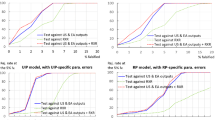Abstract
The paper analyses the impact of pecuniary externalities in a two-sector economy with an incomplete market structure. Agents in each sector choose their proportion of risky investment. Sector specific risks are assumed to be perfectly negatively correlated. It is shown that the economy is more volatile if risk markets do not exist. With a complete set of risk markets, shocks in one sector will be dampened on the aggregate level. In contrast, when risk markets are absent, pecuniary externalities arising from higher risky investment in one sector can create feedback effects in the other sector. When agents are sufficiently risk averse (their coefficient of relative risk aversion being greater than one), an individually optimal response to the increased riskiness of the price distribution will result in an even riskier price distribution: an increase in risky activity in one sector will lead to an increase in risky activity in the other sector, and this gives multiplier effects.
Similar content being viewed by others
References
Blanchard, O., and Kiyotaki, N. (1987): “Monopolistic Competition and the Effects of Aggregate Demand.”American Economic Review 77: 647–666.
Cooper, R., and John, A. (1988): “Coordinating Coordination Failures in Keynesian Models.”Quarterly Journal of Economics 103: 441–463.
Diamond, P. (1982): “Aggregate Demand Management in Search Equilibrium.”Journal of Political Economy 90: 881–894.
Greenwald, B., and Stiglitz, J. (1986): “Externalities in Economies with Imperfect Information and Incomplete Markets.”Quarterly Journal of Economics 101: 228–264.
Hart, O. (1982): “A Model of Imperfect Competition with Keynesian Features.”Quarterly Journal of Economics 97: 109–138.
Howitt, P. (1985): “Transaction Costs in the Theory of Unemployment.”American Economic Review 75: 88–100.
Illing, G. (1990): “Volatility in Distorted Economies — A Microfoundation of Keynesian Ideas?” Mimeo, University of Munich.
Newbery, D., and Stiglitz, J. (1982): “The Choice of Techniques and the Optimality of Market Equilibrium with Rational Expectations.”Journal of Political Economy 90: 223–246.
Pagano, M. (1989): “Endogenous Market Thinness and Stock Price Volatility.”Review of Economic Studies 56: 269–288.
Sandmo, A. (1970): “The Effects of Uncertainty on Savings Decisions.”Review of Economic Studies 37: 353–360.
Author information
Authors and Affiliations
Additional information
Part of this work has been done while I was visiting assistant professor at the University of Western Ontario, London, Canada.
I am grateful to Hans-Werner Sinn for helpful comments. The suggestions of the two referees have contributed to improve the paper considerably.
Rights and permissions
About this article
Cite this article
Illing, G. Multiplier effects in economies with missing risk markets. Zeitschr. f. Nationalökonomie 52, 55–70 (1990). https://doi.org/10.1007/BF01227502
Received:
Revised:
Issue Date:
DOI: https://doi.org/10.1007/BF01227502




